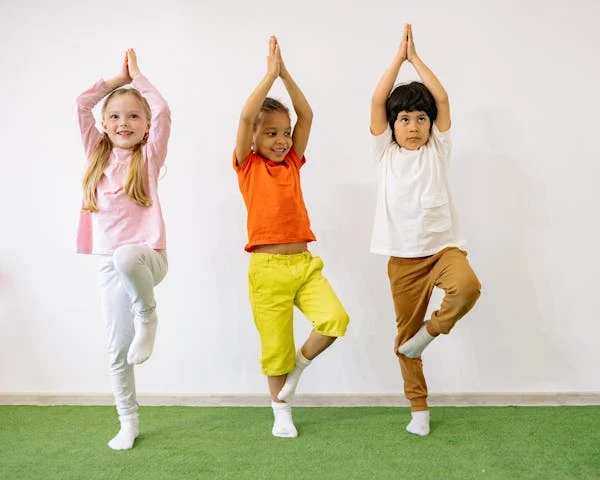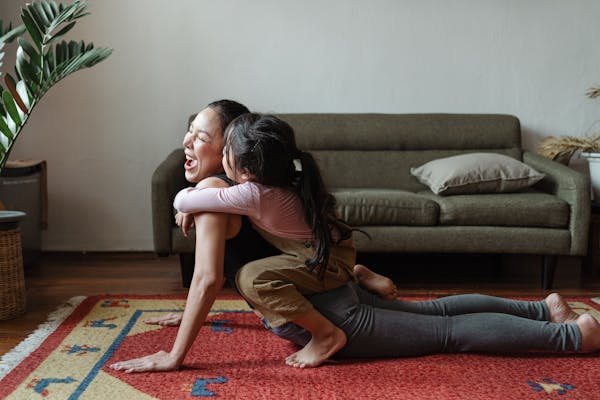Table of Contents
Introduction
Basic Yoga Poses -Yoga is a daily practice among most people, for it provides multiple physical, mental, and emotional benefits. Through yoga practice, one can attain flexibility, strength, balance, and mindfulness.
For the novice, starting with some basic poses to lay down the foundation will prepare them to attempt more challenging poses. Beginners should not fear learning yoga.
In fact, an excellent way in which one can gather confidence, adaptability, as well as fortitude for deeper practice is indeed mastering easy poses of yoga.
In this blog, we will go through the best easy yoga poses for beginners and how to do them correctly. The basic yoga poses are the foundation for more advanced practices, and incorporating them into your routine will bring about improvements in your overall well-being.
Whether you are just starting out on your yoga journey or want to solidify your practice, these poses will help you progress steadily and safely.
What is Yoga?
Yoga is a practice originating from ancient India, developed over thousands of years. It encompasses physical postures (asanas), breath control (pranayama), meditation, and ethical principles that aim to help people achieve holistic health and well-being.
The word “yoga” is derived from the Sanskrit word “yuj,” which means “to join” or “to unite,” referring to the union of body, mind, and spirit.
At its core, yoga is about finding balance, strength, and flexibility, both physically and mentally. Under regular practice, yoga provides improved posture, greater flexibility, increased strength, relief from stress, and increased mental clarity.
It has been proven to drop anxiety levels, improve the concentration of one’s mind, and bring a sense of calm.
As long as the more complicated forms of yoga are concerned, it is much easier to have a good head start with simpler, easier forms of yoga postures.
They will help beginners build a firm foundation for practice and provide a whole set of advantages of yoga, without overwhelming their bodies.
Why Beginners Should Concentrate on Simple Yoga Poses
For any beginner in yoga, learning basic yoga poses is necessary. The easy yoga poses are meant to teach the basic movements and postures that form most of any yoga practice.
More focus on the simpler poses will ensure that you are building a foundation of good alignment, which will prevent injuries and therefore lead to long-term success in your yoga journey.
1. Building a Basic Foundation
Mastering easy yoga poses will give you a solid foundation to build on, which will allow you to progress safely and effectively into more challenging postures. The key to yoga is alignment, and getting the fundamentals right at the start is crucial. For example, learning how to properly align your hips, shoulders, and spine in simple poses like Mountain Pose (Tadasana) can help prevent strain and injury later on.
2. Preventing Injury
When beginners bypass these foundational stages to jump into advanced positions, they open themselves up for injury. A simple yoga can teach you about the right move, stretch, and strengthening mechanism of your body, which also reduces the percentage of injury from such practice greatly. They provide you with opportunities to get to the yoga schedule at a convenient pace according to your current fitness stage.
3. Flexibility and Strength Improvement
The most important reason for starting with basic yoga poses is that they allow you to build strength and flexibility in a gradual manner. For instance, Downward Dog (Adho Mukha Svanasana) stretches the hamstrings and the back while strengthening the arms and core. You will see an improvement in flexibility and strength with time as you practice these regularly.
4. Improving Posture
One of the greatest advantages of yoga is that it improves posture. Easy yoga poses such as Cat-Cow Pose (Marjaryasana-Bitilasana) and Child’s Pose (Balasana) gently open the chest, stretch the spine, and release tension. Regular practice of these poses can help relieve tightness in the back and shoulders, improving your posture both on and off the mat.
Tips for Beginners Before Starting Yoga
Before you start practicing yoga, it’s essential to prepare yourself in some ways so that you are at ease and prepared for your practice. Here are a few tips for beginners:
1. Appropriate Attire and Equipment
For a comfortable and effective yoga practice, clothing must be both comfortable and flexible. Choose moisture-wicking clothing, which allows freedom of movement. A non-slip mat is essential for stability during poses, especially for standing and balancing poses.
2. Setting Up Your Space
Create a peaceful, quiet environment for your practice. This can be at home or in a yoga studio. Ensure that the space is free from distractions. Lighting, soothing music, or a calming scent like lavender can enhance your yoga experience.
3. Focusing on Breath
Breathing is an integral part of yoga. In fact, it is the foundation on which your poses should be built. Pay attention to deep, steady breaths throughout your practice. Breathing helps keep you grounded and centered during each pose. One technique that is particularly helpful for beginners is Ujjayi breathing, also known as victorious breath, which involves inhaling and exhaling through the nose while slightly constricting the throat to create a calming sound.
4. Listening to Your Body
Yoga is a personal journey, and it’s essential to listen to your body throughout your practice. If a pose feels too intense, modify it or take a break. With regular practice, you will gradually increase your flexibility and strength, but it’s important to never push past your limits. Yoga is about progress, not perfection.
Basic Yoga Poses for Beginners
Now that you know how to stand up straight and breathe, let’s start with the essentials in easy yoga poses for beginners. These positions target various parts of the body, such as your back, legs, arms, and core, thus slowly building overall strength, flexibility, and balance.
1. Mountain Pose (Tadasana)
Mountain Pose is the fundamental positioning posture from where all standing postures are performed. It may appear simple, but indeed, this is the most powerful posture that gives a fundamental position of alignment for yoga. To perform this pose, stand with your feet a little apart from each other and your arms relaxed by your sides. Activate your thighs, lift your chest, and reach your crown toward the sky.
Continue deep, steady breathing, feeling supported from below while lengthening upward.

2. Downward-Facing Dog (Adho Mukha Svanasana)
Downward-Facing Dog is a full-body stretch that stretches the arms, shoulders, back, hamstrings, and calves. Start on your hands and knees in a tabletop position, then lift your hips up towards the ceiling so your body forms an inverted “V”.
Keep your hands shoulder-width apart and your feet hip-width apart. This pose is perfect for lengthening the spine and relieving tension.


3. Cat-Cow Pose (Marjaryasana-Bitilasana)
Cat-Cow Pose is a dynamic movement that opens up the spine. Lie on your hands and knees in a tabletop position. Inhale and arch your back, opening your chest up toward the ceiling (Cow Pose), and exhale and round your back, tucking your chin toward your chest (Cat Pose). This cycle loosens the spine and frees tension in the back and neck.
4. Child’s Pose (Balasana)
Child’s Pose is a restorative, resting pose that helps to release tension in the back, hips, and shoulders. Start by kneeling on the mat and slowly bring your hips back to your heels while lowering your chest to the floor. Extend your arms forward and relax your forehead on the mat.
Take slow, deep breaths and allow your body to sink deeper into the pose with each exhale.


5. Warrior I (Virabhadrasana I)
Warrior I strengthens the legs, hips, and core and enhances concentration and balance. Begin with standing on a wide stance. Turn one foot 90 degrees outward, and bend your front knee, while keeping your back leg straight.
Extend your arms overhead and keep your torso oriented forward. Warrior I helps build stability and confidence.
How to Practice the Basic Yoga Poses Safely
Safety is a priority when practicing yoga, especially for beginners. It’s important to warm up your body before attempting any poses. Warming up helps prepare your muscles and joints, preventing injury and allowing for greater flexibility.
Take your time transitioning between poses. Rushing through the postures can lead to improper alignment and strain on the muscles. Use props such as yoga blocks or straps if needed to assist with certain poses and make them more accessible.
Breathing Techniques in Yoga
Proper breathing is a key component of yoga practice. The most basic form of breathing used in yoga is Ujjayi breathing.
This technique involves breathing through the nose while slightly constricting the back of the throat, creating a gentle, ocean-like sound. Ujjayi breathing helps to calm the mind, control the breath, and maintain focus during your practice.
Building Consistency in Your Practice
Consistency is the keyword when it comes to yoga. Though it is a little hard to do this every day initially, practicing some easy yoga poses for 15-20 minutes daily can result in good advantages. You could dedicate a certain time each day to practicing and then gradually extend the duration of your session based on your comfort level.


Conclusion
The best way to start on the yoga journey and build a solid foundation for consistent and fulfilling practice is to start with basic yoga poses. Through mastering these easy yoga poses, you will develop flexibility, strength, and mental clarity.
Yoga is not about perfection; it is about the progress that can be made in your own way and developing a mindful, balanced life. Whether you are a beginner to yoga or need to fine-tune your practice, starting with these foundational poses will guide you on the path to a healthier body and mind.

Pingback: Yoga for Cholesterol: Natural Means to Control Your Cholesterol Levels 2025 -
Pingback: Hypertension Reducing Yoga: A Path to Tension Relief and Better Health 2025 -